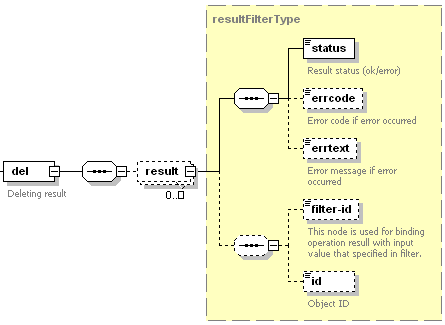Removing Sites
Sites can be deleted individually or in bulk by sending a del request packet to the Panel.
Request Packet Structure
A request XML packet that deletes sites should include the del operation node:
<packet version="1.6.3.0">
<site>
<del>
...
</del>
</site>
</packet>
The del node does not have a separate type, it is nested within the
complex type (site.xsd). The it has the following graphics
representation:

Note: The interactive schema navigator for all request packets is available here: http://plesk.github.io/api-schemas/1.6.8.0/agent_input.svg.
-
filter, required
It indicates sites to be deleted. Data type: siteFilterType (
site.xsd). To see the structure of this node, proceed to topic Available Filters.
Response Packet Structure
The del node of the response packet is structured as follows:

Note: The interactive schema navigator for all response packets is available here: http://plesk.github.io/api-schemas/1.6.8.0/agent_output.svg.
-
result, optional
It wraps the result of the requested operation. It can be missing if some error occurs before the validation starts. Data type: resultFilterType (
common.xsd). -
status, required
It returns the execution status of the operation. Data type: string. Allowed values: ok | error.
-
errcode, optional
It is used to return an error code when the operation fails. Data type: unsignedInt.
-
errtext, optional
Can be used to return an error message if the operation fails. Data type: string.
-
filter-id, optional
It is always present and used to return the parameter by which the site was filtered by in the request packet. Data type: anySimple.
-
id, optional
It is missing if the request packet fails before the validation on the server side. If present, this node identifies the deleted site. Data type: integer.
Samples
This request removes a site:
<packet version="1.6.3.0">
<site>
<del>
<filter>
<id>18</id>
</filter>
</del>
<del>
<filter>
<name>example.net</name>
</filter>
</del>
</site>
</packet>
Response:
<packet version="1.6.3.0">
<site>
<del>
<result>
<status>ok</status>
<filter-id>18</filter-id>
<id>18</id>
</result>
</del>
</site>
</packet>
This packet contains different filtering rules to remove sites:
<packet version="1.6.3.0">
<site>
<del>
<filter>
<id>123</id>
<id>124</id>
</filter>
</del>
<del>
<filter>
<name>example.com</name>
<name>example.net</name>
</filter>
</del>
</site>
</packet>
This packet requests to remove all sites owned by a packet sender:
<packet version="1.6.3.0">
<site>
<del>
<filter/>
</del>
</site>
</packet>